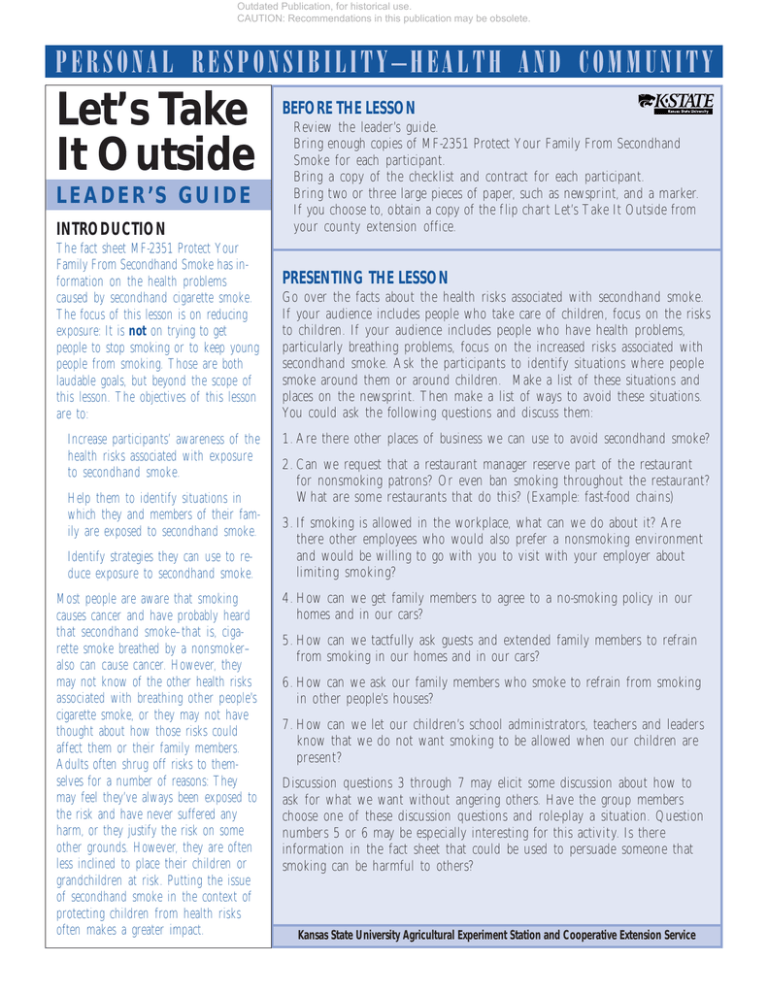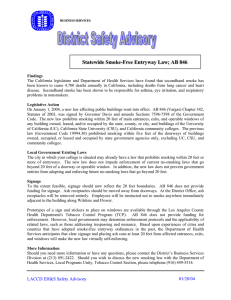
Outdated Publication, for historical use.
CAUTION: Recommendations in this publication may be obsolete.
PERSONAL RESPONSIBILITY–HEALTH AND COMMUNITY
Let’s Take
It Outside
LEADER’S GUIDE
INTRODUCTION
The fact sheet MF-2351 Protect Your
Family From Secondhand Smoke has information on the health problems
caused by secondhand cigarette smoke.
The focus of this lesson is on reducing
exposure: It is not on trying to get
people to stop smoking or to keep young
people from smoking. Those are both
laudable goals, but beyond the scope of
this lesson. The objectives of this lesson
are to:
• Increase participants’ awareness of the
health risks associated with exposure
to secondhand smoke.
• Help them to identify situations in
which they and members of their family are exposed to secondhand smoke.
• Identify strategies they can use to reduce exposure to secondhand smoke.
Most people are aware that smoking
causes cancer and have probably heard
that secondhand smoke–that is, cigarette smoke breathed by a nonsmoker–
also can cause cancer. However, they
may not know of the other health risks
associated with breathing other people’s
cigarette smoke, or they may not have
thought about how those risks could
affect them or their family members.
Adults often shrug off risks to themselves for a number of reasons: They
may feel they’ve always been exposed to
the risk and have never suffered any
harm, or they justify the risk on some
other grounds. However, they are often
less inclined to place their children or
grandchildren at risk. Putting the issue
of secondhand smoke in the context of
protecting children from health risks
often makes a greater impact.
BEFORE THE LESSON
• Review the leader’s guide.
• Bring enough copies of MF-2351 Protect Your Family From Secondhand
Smoke for each participant.
• Bring a copy of the checklist and contract for each participant.
• Bring two or three large pieces of paper, such as newsprint, and a marker.
• If you choose to, obtain a copy of the flip chart Let’s Take It Outside from
your county extension office.
PRESENTING THE LESSON
Go over the facts about the health risks associated with secondhand smoke.
If your audience includes people who take care of children, focus on the risks
to children. If your audience includes people who have health problems,
particularly breathing problems, focus on the increased risks associated with
secondhand smoke. Ask the participants to identify situations where people
smoke around them or around children. Make a list of these situations and
places on the newsprint. Then make a list of ways to avoid these situations.
You could ask the following questions and discuss them:
1. Are there other places of business we can use to avoid secondhand smoke?
2. Can we request that a restaurant manager reserve part of the restaurant
for nonsmoking patrons? Or even ban smoking throughout the restaurant?
What are some restaurants that do this? (Example: fast-food chains)
3. If smoking is allowed in the workplace, what can we do about it? Are
there other employees who would also prefer a nonsmoking environment
and would be willing to go with you to visit with your employer about
limiting smoking?
4. How can we get family members to agree to a no-smoking policy in our
homes and in our cars?
5. How can we tactfully ask guests and extended family members to refrain
from smoking in our homes and in our cars?
6. How can we ask our family members who smoke to refrain from smoking
in other people’s houses?
7. How can we let our children’s school administrators, teachers and leaders
know that we do not want smoking to be allowed when our children are
present?
Discussion questions 3 through 7 may elicit some discussion about how to
ask for what we want without angering others. Have the group members
choose one of these discussion questions and role-play a situation. Question
numbers 5 or 6 may be especially interesting for this activity. Is there
information in the fact sheet that could be used to persuade someone that
smoking can be harmful to others?
Kansas State University Agricultural Experiment Station and Cooperative Extension Service
Outdated Publication, for historical use.
CAUTION: Recommendations in this publication may be obsolete.
LET’S TAKE IT OUTSIDE
LEADER’S GUIDE
This lesson contains a checklist for assessing exposure to secondhand smoke for both adults and children, a contract
to sign, and a contract for parents to sign to reduce exposure to secondhand smoke. Ask the participants at your
program first to assess their exposure, and ask parents to assess their children’s exposure to secondhand smoke. Next,
ask if they would be willing to sign one or both of the contracts, as appropriate, for reducing exposure to secondhand
smoke. Ask them to sign the contract, keep the top for themselves and give one copy to you.
COMMUNITY ACTIVITIES
Participants at a group lesson could decide to staff a display on the health risks of secondhand smoke at one of the
events listed below. Or they could decide to make a list of restaurants and other businesses in town that do not allow
smoking and circulate this list.
These checklists and contracts can be used with a display on the risks of secondhand smoke and with the fact sheet
MF-2351 Protect Your Family From Secondhand Smoke at health fairs, school enrollment events, school open houses,
health clinics, PTA meetings, regularly scheduled club meetings, employee groups, and other places where adults
who care about their health and their children’s health gather. You can ask people if they would be willing to assess
their or their child’s exposure to secondhand smoke, and then sign a contract, turn one copy back to you, and keep a
signed copy for themselves. Keep track of the number of signed contracts you receive.
LESSON LEADER: Send the following back to your county extension office.
• The number of people who assessed their exposure to secondhand smoke._____
• The number of people who signed a contract agreeing to protect their own health by reducing their
exposure to secondhand smoke._____
• The number of parents who assessed their children’s exposure to secondhand smoke._____
• The number of parents who signed a contract agreeing to protect their children’s health by reducing their
exposure to secondhand smoke._____
• Other actions taken by a group _____________________________________________________________
• There were _____ people present at a meeting on secondhand smoke.
• Type of meeting_________________________________________________________________________
• Lesson leader’s name___________________________ Telephone_________________________________
• County__________________________
County agents: Send to Marilyn Bode, Extension Housing Specialist, 215 Justin ATID,
Kansas State University, Manhattan, KS 66506.
Author: Marilyn Bode, Extension Housing Specialist
Acknowledgment: Thanks to Cindy Evans, County Extension Agent in Shawnee County, for suggestions and review.
Publications from Kansas State University are available on the World Wide Web at: http://www.oznet.ksu.edu
Contents of this publication may be freely reproduced for educational purposes. All other rights reserved. In each case, credit Marilyn Bode, Ph.D., “Let’s Take it Outside,” Kansas State University, August 1998.
Kansas State University Agricultural Experiment Station and Cooperative Extension Service
MF-2350
AUGUST 1998
It is the policy of Kansas State University Agricultural Experiment Station and Cooperative Extension Service that all persons shall have equal opportunity and access to its educational programs, services, activities, and materials
without regard to race, color, religion, national origin, sex, age or disability. Kansas State University is an equal opportunity organization. Issued in furtherance of Cooperative Extension Work, Acts of May 8 and June 30, 1914, as
amended. Kansas State University, County Extension Councils, Extension Districts, and United States Department of Agriculture Cooperating, Marc A. Johnson, Director.
File code: HOUSING
NP



